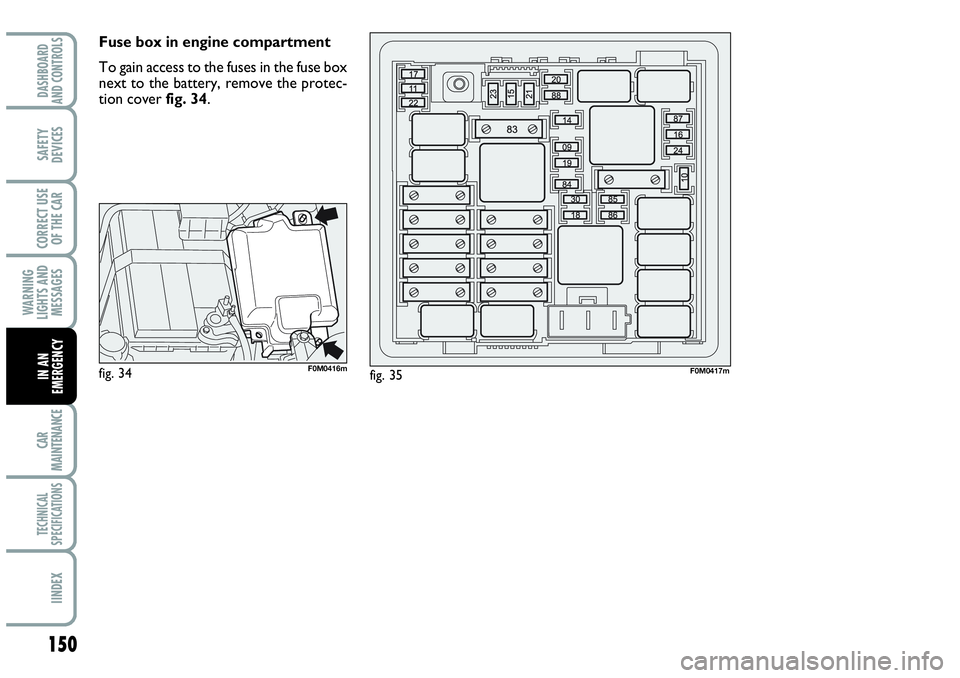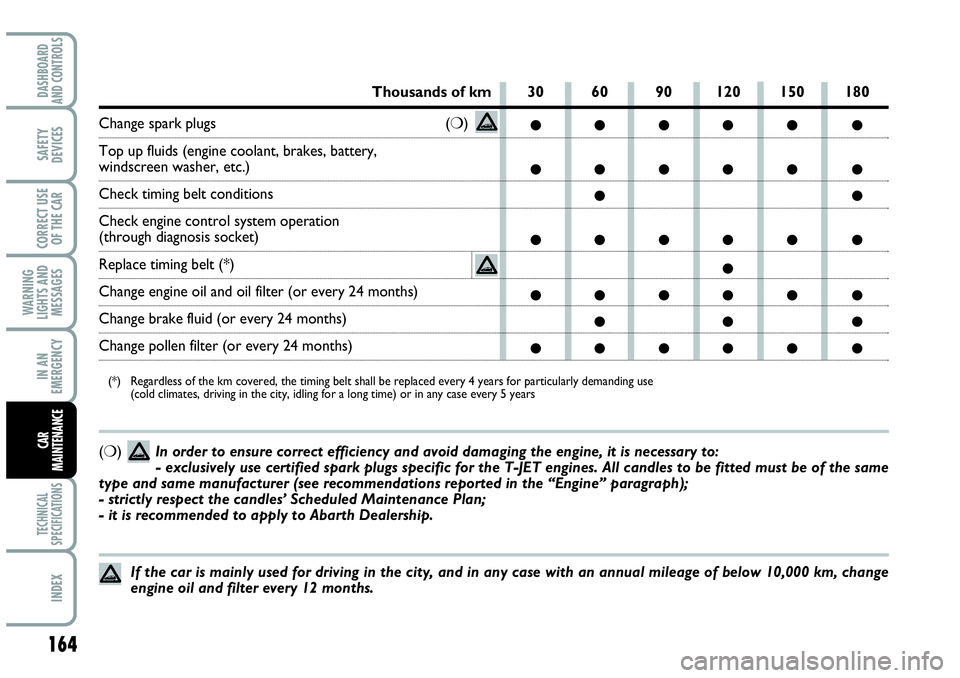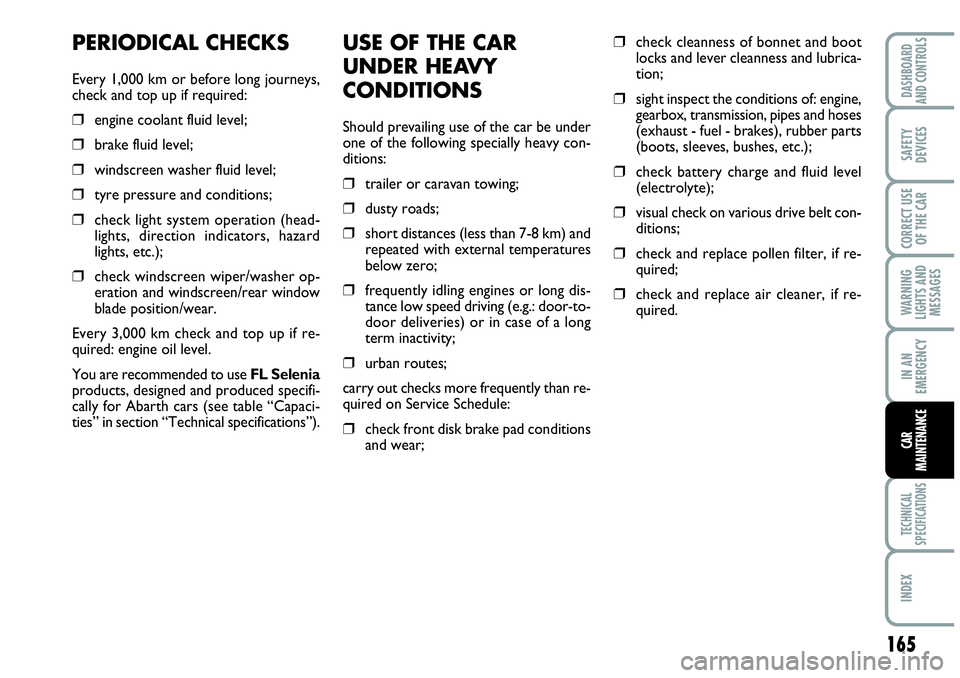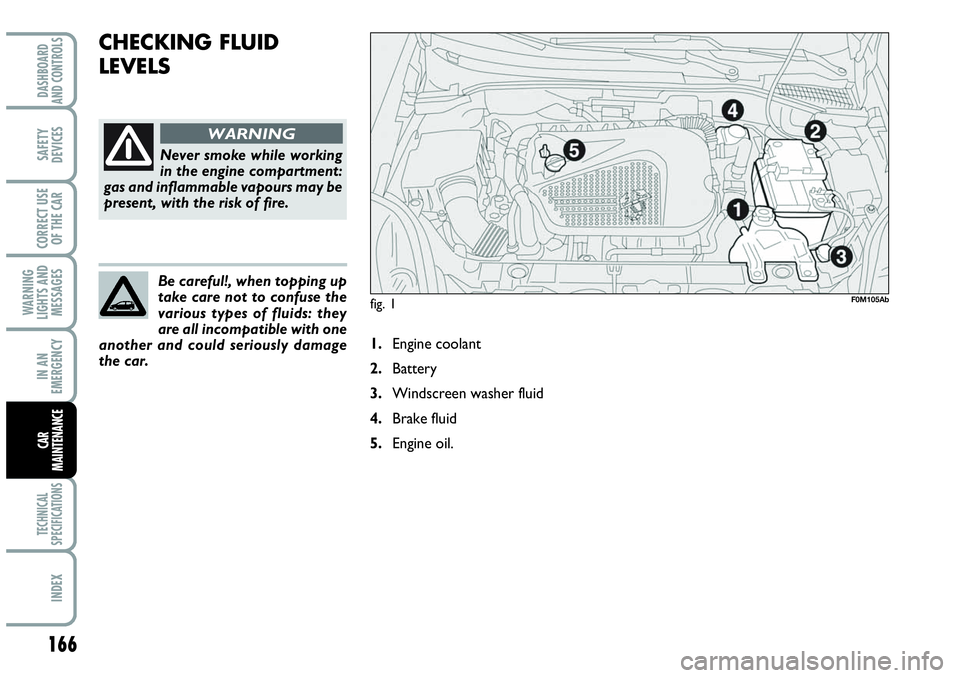battery Abarth Grande Punto 2010 Owner handbook (in English)
[x] Cancel search | Manufacturer: ABARTH, Model Year: 2010, Model line: Grande Punto, Model: Abarth Grande Punto 2010Pages: 207, PDF Size: 3.01 MB
Page 152 of 207

150
WARNING
LIGHTS AND
MESSAGES
CAR
MAINTENANCE
TECHNICAL
SPECIFICATIONS
IINDEX
DASHBOARD
AND CONTROLS
SAFETY
DEVICES
CORRECT USE
OF THE CAR
IN AN
EMERGENCY
Fuse box in engine compartment
To gain access to the fuses in the fuse box
next to the battery, remove the protec-
tion cover fig. 34.
fig. 34F0M0416mfig. 35F0M0417m
Page 154 of 207

152
WARNING
LIGHTS AND
MESSAGES
CAR
MAINTENANCE
TECHNICAL
SPECIFICATIONS
IINDEX
DASHBOARD
AND CONTROLS
SAFETY
DEVICES
CORRECT USE
OF THE CAR
IN AN
EMERGENCY
7.5
7.5
5
5
10
5
20
20
20
20 1
8
13
2
5
11
4
6
14
7
FUSE SUMMARY TABLE
Fuse box on dashboard fig. 33
USERSFUSE AMPERE
Right dipped headlamp
Left dipped headlamp, headlamp alignment corrector
INT/A power supply for relay coils in engine fuse junction unit and relay coils in
body computer control unit
Front courtesy light, lights in visors, luggage compartment light
+ battery power supply for EOBD diagnostic socket, automatic climate control
system control unit, alarm siren, car radio, convergence control unit, tyre
monitoring control unit
INT power supply for instrument panel, switch on brake pedal (N.O. contact),
third brake light
Door locking/unlocking motors, dead lock activation motors, tailgate unlocking motor
Windscreen/rearscreen washer pump
Electric window motor on driver’s front door
Electric window motor on passenger side front door
Page 159 of 207

157
WARNING
LIGHTS AND
MESSAGES
CAR
MAINTENANCE
TECHNICAL
SPECIFICATIONS
INDEX
DASHBOARD
AND CONTROLS
SAFETY
DEVICES
CORRECT USE
OF THE CAR
IN AN
EMERGENCY
The liquid contained in the
battery is poisonous and cor-
rosive. Avoid contact with the skin or
eyes. The battery should be charged
in a well ventilated place, away from
naked flames or possible sources of
sparks: danger of explosion and fire.
WARNINGCharge the battery as follows:
❒ disconnect battery negative terminal;
❒ connect the charger cables to the bat-
tery terminals, observing the poles;
❒ turn on the charger;
❒ when you have finished, turn the charg-
er off before disconnecting the battery;
❒ reconnect battery negative terminal.
IF THE BATTERY IS FLAT
WARNING The battery charging proce-
dure is described only for information pur-
poses. This operation should be carried
out by Abarth Dealership.
Charging should be slow at a low amp rat-
ing for 24 hours. Charging for a longer
time may damage the battery.
Page 160 of 207

158
WARNING
LIGHTS AND
MESSAGES
CAR
MAINTENANCE
TECHNICAL
SPECIFICATIONS
IINDEX
DASHBOARD
AND CONTROLS
SAFETY
DEVICES
CORRECT USE
OF THE CAR
IN AN
EMERGENCY
fig. 38F0M042Ab
JACKING THE CAR
If the car is to be lifted, go to a Abarth
Dealership which is equipped with the arm
hoist or workshop lift.Do not attempt to charge a
frozen battery: it must first-
ly be thawed, otherwise it may burst.
If freezing has occurred, the battery
should be checked by skilled person-
nel to make sure that the internal el-
ements are not damaged and that the
body is not cracked, with the risk of
leaking poisonous and corrosive acid.
WARNING
Jack up the car only by positioning the jack
arms or the shop jack in the points shown
in the figure.
IMPORTANT In case of side lift by means
of a workshop hoister, be careful not to
damage the aerodynamic spoilers (skirts).
Page 163 of 207

161
WARNING
LIGHTS AND
MESSAGES
TECHNICAL
SPECIFICATIONS
INDEX
DASHBOARD
AND CONTROLS
SAFETY
DEVICES
CORRECT USE
OF THE CAR
IN AN
EMERGENCY
CAR
MAINTENANCE
SCHEDULED SERVICING ................................................ 162
SERVICE SCHEDULE........................................................... 163
PERIODICAL CHECKS........................................................ 165
USE OF THE CAR UNDER HEAVY CONDITIONS ... 165
CHECKING FLUID LEVELS................................................ 166
AIR FILTER ............................................................................ 170
POLLEN FILTER ................................................................... 170
BATTERY................................................................................ 171
WHEELS AND TYRES......................................................... 173
RUBBER HOSES.................................................................... 174
WINDSCREEN/REAR WINDOW WIPERS ................... 174
BODYWORK........................................................................ 176
INTERIORS ............................................................................ 179
C C
A A
R R
M M
A A
I I
N N
T T
E E
N N
A A
N N
C C
E E
Page 166 of 207

(❍) In order to ensure correct efficiency and avoid damaging the engine, it is necessary to:
- exclusively use certified spark plugs specific for the T-JET engines. All candles to be fitted must be of the same
type and same manufacturer (see recommendations reported in the “Engine” paragraph);
- strictly respect the candles’ Scheduled Maintenance Plan;
- it is recommended to apply to Abarth Dealership.
164
WARNING
LIGHTS AND
MESSAGES
TECHNICAL
SPECIFICATIONS
INDEX
DASHBOARD
AND CONTROLS
SAFETY
DEVICES
CORRECT USE
OF THE CAR
IN AN
EMERGENCY
CAR
MAINTENANCE
30 60 90 120 150 180
●●●●● ●
●●●●● ●
●●
●●●●● ●
●
●●●●● ●
●● ●
●●●●● ●
Thousands of km
Change spark plugs (❍)
Top up fluids (engine coolant, brakes, battery,
windscreen washer, etc.)
Check timing belt conditions
Check engine control system operation
(through diagnosis socket)
Replace timing belt (*)
Change engine oil and oil filter (or every 24 months)
Change brake fluid (or every 24 months)
Change pollen filter (or every 24 months)
(*) Regardless of the km covered, the timing belt shall be replaced every 4 years for particularly demanding use
(cold climates, driving in the city, idling for a long time) or in any case every 5 years
If the car is mainly used for driving in the city, and in any case with an annual mileage of below 10,000 km, change
engine oil and filter every 12 months.
Page 167 of 207

USE OF THE CAR
UNDER HEAVY
CONDITIONS
Should prevailing use of the car be under
one of the following specially heavy con-
ditions:
❒trailer or caravan towing;
❒dusty roads;
❒short distances (less than 7-8 km) and
repeated with external temperatures
below zero;
❒frequently idling engines or long dis-
tance low speed driving (e.g.: door-to-
door deliveries) or in case of a long
term inactivity;
❒urban routes;
carry out checks more frequently than re-
quired on Service Schedule:
❒check front disk brake pad conditions
and wear;
❒check cleanness of bonnet and boot
locks and lever cleanness and lubrica-
tion;
❒sight inspect the conditions of: engine,
gearbox, transmission, pipes and hoses
(exhaust - fuel - brakes), rubber parts
(boots, sleeves, bushes, etc.);
❒check battery charge and fluid level
(electrolyte);
❒visual check on various drive belt con-
ditions;
❒check and replace pollen filter, if re-
quired;
❒check and replace air cleaner, if re-
quired.
PERIODICAL CHECKS
Every 1,000 km or before long journeys,
check and top up if required:
❒engine coolant fluid level;
❒brake fluid level;
❒windscreen washer fluid level;
❒tyre pressure and conditions;
❒check light system operation (head-
lights, direction indicators, hazard
lights, etc.);
❒check windscreen wiper/washer op-
eration and windscreen/rear window
blade position/wear.
Every 3,000 km check and top up if re-
quired: engine oil level.
You are recommended to use FL Selenia
products, designed and produced specifi-
cally for Abarth cars (see table “Capaci-
ties” in section “Technical specifications”).
165
WARNING
LIGHTS AND
MESSAGES
TECHNICAL
SPECIFICATIONS
INDEX
DASHBOARD
AND CONTROLS
SAFETY
DEVICES
CORRECT USE
OF THE CAR
IN AN
EMERGENCY
CAR
MAINTENANCE
Page 168 of 207

166
WARNING
LIGHTS AND
MESSAGES
TECHNICAL
SPECIFICATIONS
INDEX
DASHBOARD
AND CONTROLS
SAFETY
DEVICES
CORRECT USE
OF THE CAR
IN AN
EMERGENCY
CAR
MAINTENANCE
CHECKING FLUID
LEVELS
Never smoke while working
in the engine compartment:
gas and inflammable vapours may be
present, with the risk of fire.
WARNING
Be careful!, when topping up
take care not to confuse the
various types of fluids: they
are all incompatible with one
another and could seriously damage
the car.
fig. 1
1.Engine coolant
2.Battery
3.Windscreen washer fluid
4.Brake fluid
5.Engine oil.
F0M105Ab
Page 173 of 207

171
WARNING
LIGHTS AND
MESSAGES
TECHNICAL
SPECIFICATIONS
INDEX
DASHBOARD
AND CONTROLS
SAFETY
DEVICES
CORRECT USE
OF THE CAR
IN AN
EMERGENCY
CAR
MAINTENANCE
BATTERY
The car fits a low-maintenance battery: no
top-ups with distilled water are needed in
normal conditions of use.
INSPECTING THE CHARGE
AND THE ELECTROLYTE LEVEL
Inspection operations must be carried out
by specialised personnel, following the
prescriptions contained in the Use and
maintenance booklet. Any top-up opera-
tions must be carried out by specialised
personnel and by Abarth Dealership.Running the battery with an
excessively low liquid level
will damage the battery beyond re-
pair and even cause an explosion.
WARNINGIncorrect assembly of electric
and electronic devices may
cause severe damage to your
car. Go to a Abarth Dealer-
ship if you want to install accessories
(alarms, mobile phone, etc.): they will
suggest the most suitable devices and
advise you if a higher capacity battery
needs to be installed.
Batteries contain substances
that can be very dangerous
for the environment. t is ad-
visable to have the battery
changed by a Abarth Dealership where
it will be disposed of according to the
law.
Page 174 of 207

172
WARNING
LIGHTS AND
MESSAGES
TECHNICAL
SPECIFICATIONS
INDEX
DASHBOARD
AND CONTROLS
SAFETY
DEVICES
CORRECT USE
OF THE CAR
IN AN
EMERGENCY
CAR
MAINTENANCE
IMPORTANT If the charge level remains
for a long time under 50%, the battery is
damaged by sulphation, reducing its ca-
pacity and starting attitude.
The battery will also be more at risk of
freezing (e.g. already at -10°C). Refer to
the paragraph “Car inactivity” in “Starting
and driving” if the car is left parked for a
long time.
If after buying the car, you want to install
electric accessories which require per-
manent electric supply (alarm, etc.) con-
tact Abarth Dealership whose qualified
personnel, in addition to suggesting the
most suitable devices, will evaluate the
overall electric absorption, checking
whether the car’s electric system is capa-
ble of withstanding the load required, or
whether it should be integrated with a
more powerful battery.
Since these devices continue absorbing en-
ergy even when the ignition key is off, they
gradually run down the battery. USEFUL ADVICE FOR
LENGTHENING THE LIFE OF
YOUR BATTERY
To avoid draining your battery and length-
en its life, observe the following indica-
tions:
❒when you park the car, ensure the
doors, tailgate and bonnet are closed
properly;
❒switch off all lights inside the car: the
car is however equipped with a system
which switches all internal lights off au-
tomatically;
❒do not keep accessories (e.g. sound sys-
tem, hazard lights, etc.) switched on for
a long time when the engine is not run-
ning;
❒before performing any operation on the
electrical system, disconnect the bat-
tery negative cable;
❒battery terminals shall always be per-
fectly tightened.
If the vehicle must remain
unused for a long time at
very low temperature, remove the
battery and carry it to a warm place,
to avoid freezing.
WARNING
When you must perform any
operation on the battery or
near it, always protect your eyes with
the special goggles.
WARNING